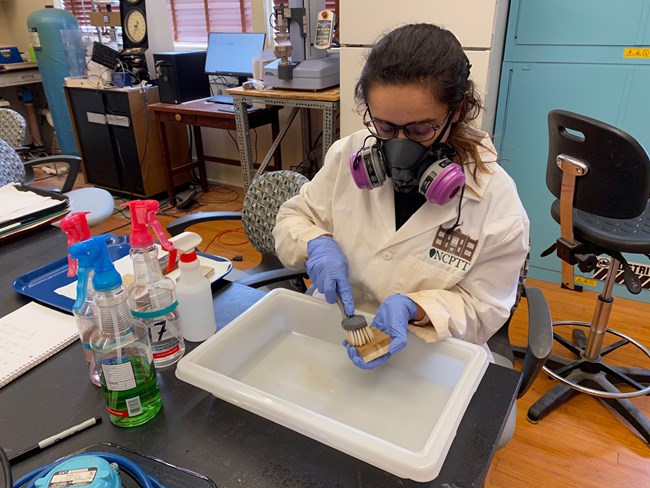Last updated: October 7, 2021
Article
Removing Crude Oil from Historic Structures

NCPTT researchers continue to study ways to remove crude oil from cultural resources. Most recently, Vrinda Jariwala, an architect and conservator from New Delhi, India, studies the use of EPA approved surface washing agents for removing different types of crude oil from historic materials. Her job is to evaluate the effectiveness of surface washing agents and devise practical methods to apply treatments to buildings, bridges, and other historically significant cultural resources.
The Deep Water Horizon Oil Spill and the Exxon Valdez Spill (1989) are etched into the memory of people around the world. These spills took place on large bodies of water, but other spills can happen inland. For example, one of the largest inland oil spills in U.S. history happened when the line 3 pipeline near Grand Rapids, Minnesota ruptured and spilled 1.7 million gallons of oil in March 1991. Our researchers have looked at an overlay of pipelines running through the United States with maps of National Park Service National Register properties, sites, and districts. The potential of cultural resources being oiled by an inland spill is possible.
With the support of the U.S. Department of the Interior Inland Oil Spill Preparedness Project (IOSPP) NCPTT began research with Phase I, taking place from January 2018- May 2019. The second phase of this work was undertaken from June 2019-August 2019. NCPTT began evaluating the effectiveness of seven surface washing agents to remove two types of crude oil from surrogate cultural materials such as brick, concrete, southern pine, and Douglas fir. The crude oils studied included West Texas Intermediate (WTI) from Galveston, TX, U.S.A, or Access West Winter Blend (AWW) from Alberta, Canada.
This work, carried out by Elizabeth Salmon, helped build our understanding of surface washing agent performance and the crude oils. There are two kinds of SWA’s lift and float and lift and disperse. In the first two stages, it was clear that lift and disperse agents especially Nokomis 5W and Simple Green with an active chemical which includes ethoxylated alcohols were more successful. Also, with her explorations in the various application methods, it helped us find the most suitable methods to remove crude oil. Also, some lift and float agents persisted in historic materials and mobilized oil. It is of utmost importance that the soiled surface is treated as soon as possible.
Jariwala’s work has focused on examining more SWAs. The substrates for this phase include – Brick, Concrete, Sandstone, and Yellow Pine. We continue to explore the same two crude oils –low to medium viscosity – WTI, and diluted bitumen – AWW. With the success of Elizabeth’s work, we decided to look at SWAs with the active component of ethoxylated alcohols. When applied on the surface it acts like surfactants and helps pull the oil away. Along with this, an SWA based on D-Limonene is also used for this phase. The success of the study is to find surface washing agent and process which could best restore the physical and chemical properties that material had before oil exposure, as measured qualitatively and quantitatively. Data is measured by documenting changes in color, gloss character, surface roughness, penetration depth, and aptitude for water vapor transmission.
NCPTT has spent ten years studying the effects of oil spills on cultural resources in order to be prepared for the next disaster. Within days of the Deep Water Horizon Oil Spill of 2010, NCPTT’s staff were meeting with the nation’s top architectural conservators and discussing methods to protect structures like Fort Morgan at the mount of Mobile Bay, Alabama. Their teams worked at Fort Livingston on Grand Terre Island to evaluate the effects of the Deep Water Horizon Spill on the large tabby and brick fortification. They were able to take oil samples, evaluate cleaning methods, and follow the conditions of the building over the course of a year.
